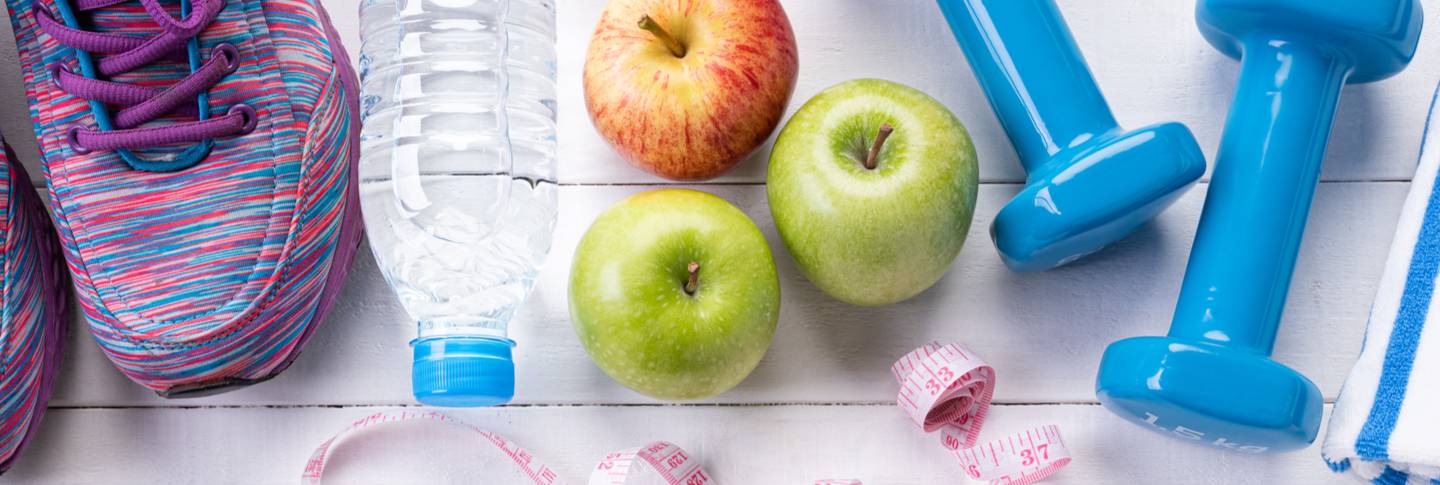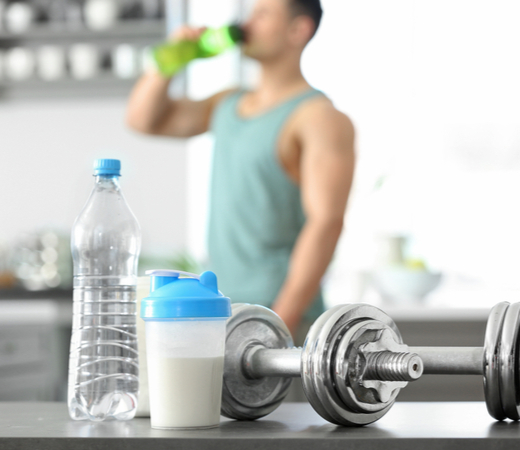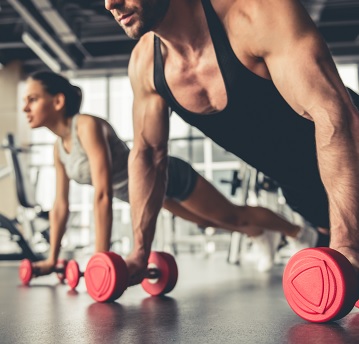
Sports Nutrition
Nutrition and Sport
Nutrition and exercise physiology are closely linked. A suitable diet is the foundation of sports performance: it provides not only the fuel necessary for muscular and cerebral work, but also the essential elements for the synthesis and repair of muscles and joint tissues.
PHYSIOPERF exercise diet products: an essential aid in the search for performance
We sometimes hear that a balanced diet satisfies the energy needs of athletes and that dietetic exercise products have no use in the search for performance. However, the study of the physiology of physical exercise, the different sources of food energy and the role of nutrients in energy metabolism, prove the need to adapt one's diet by associating it with dietetic products of the effort to improve performance.
The THERASCIENCE Laboratory, one of the European leaders in the field of medical nutrition, has designed a range of dietetic exercise products : PHYSIOPERF. It has been specially developed to help you reach your sporting goals.

Specific products before, during and after exercise
The nutritional needs of your body are not the same depending on the phase of the effort you are in (before, during or after). It is according to these specific needs that the THERASCIENCE Laboratory research and development team formulated the PHYSIOPERF range. We therefore provide you with the most suitable products, depending on the phase of the competition or training where you are.
A. THE DETERMINING FACTORS OF SPORTING PERFORMANCE
Energy, hydration and micronutrient supplementation are the three main axes of the development of a nutritional program for performance improvement.
Meeting these requirements is not as simple as you might think. Indeed, many physiological and nutritional parameters come into play: energy intake, quantities and concentrations of carbohydrates, type of carbohydrates, digestion and assimilation of nutrients, hydration, osmolarity of drinks, compensation for sweat losses, specific micronutrient intakes ... So many considerations to take into account when you want to improve and optimize your sports performance.
It is by respecting these different requirements (exposed in the following chapters) that the research and development team of the THERASCIENCE Laboratory developed the PHYSIOPERF range.
B. ENERGY
Glucose, the energy substrate of the organism
Glucose is the main immediately available source of energy for muscle and the central nervous system. It comes mostly from carbohydrates in food, and is then stored by the liver and muscles as glycogen.
Adenosine triphosphate (ATP) is the only substrate used directly for muscle contractions. However, the stock of ATP present in the organism being very low, it must be continuously replenished.
Glucose contributes to the regeneration of ATP through 3 energy channels, different depending on the intensity-duration configuration of the sport practiced :
- In the case of a short effort of high intensity (sprint, high jump, long jump, strength sport ...), the anaerobic alactic sector (15 seconds) synthesizing ATP from creatine phosphate, and the lactic anaerobic sector (15 seconds to 2 minutes) using muscle glycogen, are in the majority.
- In the case of a long effort of lower intensity (running, cycling, etc.), the aerobic sector is preponderant. It mainly mobilizes muscle glycogen (the first 90 minutes) then blood glucose from hepatic glycogen (approximately 2 to 3 hours of reserves depending on the intensity of the effort). Blood glucose therefore comes only from the liver (apart from food intake).
The two ways that the liver produces glucose are glycogenolysis and neoglucogenesis. Their relative contribution depends on the intensity and duration of the effort. In addition, fat reserves gradually participate in the synthesis of muscle ATP. The level of training can modify the mobilization of energy fuels during exercise by reducing the use of glucose in favor of that of fat reserves.
The intake of carbohydrates through drinks or energetic foods saves muscle and liver glycogen reserves, a major challenge for athletes during an effort greater than 90 minutes.
The intake of carbohydrates through drinks or energetic foods saves muscle and liver glycogen reserves, a major challenge for athletes during an effort greater than 90 minutes.

We then understand the interest of carbohydrates in the diet of athletes :
- Before exercise, to allow you to build up your energy reserves in glycogen and therefore to delay the exhaustion period. The glycogen content of muscle is a direct function of the proportion of carbohydrates in the diet
- During exercise, to allow you to "push your limits" by supplying the blood circulation with glucose and slowing the exhaustion of hepatic glycogen.
- After exercise, to allow you to quickly replenish your glycogenic reserves.
The differents types of carbohydrtes
Today, we are no longer talking about "slow" or "fast" carbohydrates but rather carbohydrates with a low or high glycemic index.
- Carbohydrates with a high glycemic index rapidly increase the level of carbohydrates in the blood (glucose, sucrose, dextrose, maltodextrins ...) ;
- Carbohydrates with a low glycemic index provide prolonged energy over time (starch, fructose).
Which carbohydrates are preferred ?
The choice of carbohydrates must be made according to the time (before, during, after the effort), the intensity of the effort and, for liquids, according to the desired osmolarity of the drink.
Low or medium glycemic index complex carbohydrates like pasta, rice, potatoes consumed several days to several hours (5 days to 3 hours) before your competition, allow you to fill up on energy.
Carbohydrates with a high glycemic index such as glucose, maltose, dextrose, sucrose and maltodextrins, consumed regularly just before and during exercise, are quickly absorbed and help replenish the glucose circulating in the body..
After exercise, they also help replenish muscle energy reserves to better recover and recharge energy.
Fructose (fruit sugar) has a low glycemic index. It causes a rapid rise in blood sugar, low but constant, providing lasting energy over time.
Fructose helps regulate your blood sugar and prevent the appearance of insulin spikes, which can lead to secondary hypoglycemia (reduced concentration, fatigue, feeling unwell, sweating, sometimes painful hunger).
During recovery, fructose makes it possible to specifically reconstitute the hepatic glycogen.
Maltodextrins, carbohydrates with a high glycemic index, have the advantage of reducing the osmolarity of drinks while maintaining their energy content, thus limiting the risks of dehydration.
C. HYDRATION AND MICRONUTRITIONAL SUPPLEMENTATION
Compensate for water losses
Physical activity leads to water loss through the skin (sweat), the respiratory system (especially when the air is dry) and the urine.
Only the evaporation of sweat on the surface of your skin can eliminate the heat produced during physical activity and therefore maintain your body at a temperature compatible with the pursuit of muscular activity.
A water loss of 2% induces a drop in your performance by 20%
Dehydration of more than 4% of body weight would be dangerous
This is why the American College of Sports Medicine recommends consuming between 600 and 1,200 ml of water per hour of exercise
Dehydration promotes tendonitis, cramps and other muscle disturbances. Hydrating is physiologically essential. PHYSIOPERF drinks guarantee optimal hydration and a carbohydrate intake adapted to your needs.
Tips for optimal hydration
- Learn to hydrate yourself during training ;
- Choose a drink suited to the effort and the temperature ;
- Drink from the start of the effort, never wait for the feeling of thirst, it's already too late !
- Hydrate at the end of the effort for better recovery.
It is important to hydrate regularly before, during and after exercise, favoring, in theory, the absorption of large volumes, of the order of 150 to 250 ml. In practice, the problem is more complex due to individual tolerance to distension and filling of the stomach. Everyone must therefore determine the maximum volume that they can ingest per intake in order to avoid any discomfort during exercise.
Restore electrolytes and micronutrient
The electrolyte composition of the blood changes during exercise. The significant losses of electrolytes, caused by water in the form of sweat, are well detailed in the scientific literature for athletes practicing an endurance sport. The electrolytes and micronutrients lost are sodium, chlorine, potassium, magnesium, calcium, vitamin C, copper, zinc, chromium and selenium.
The intake of sodium chloride is imperative and fundamental to avoid the reduction of sodium and blood chlorine during very long exercises. This decrease is responsible for the decline in performance and can lead to discomfort. It is therefore advisable to provide between 0.5 and 1 g of sodium chloride per liter of ingested drink, regardless of the type of effort. This addition does not increase the intestinal absorption of water, but it limits the decrease in plasma volume during exercise and promotes retention of extracellular fluid volume. Avoid too high concentrations, which may give a brackish taste detrimental to the consumption of drink during exercise. Salt intake in the form of tablets or dragees is not recommended because they can worsen dehydration and promote the onset of digestive disorders.
The intake of potassium in athletes practicing regular prolonged physical activity in a hot environment makes it possible to compensate for urinary and sweat losses of potassium, which can be high.
Provide antioxidants
During exercise, the sportsman's body is subjected to an increased production of free radicals.These highly reactive and harmful molecules are naturally generated by our body from oxygen, due to :
- increased oxygen consumption ;
- inflammatory reactions ;
- ischemia-reperfusion processes in the tissues.
Free radicals are the cause of oxidative damage leading to muscle and tendon microlesions, which in the long run can lead to real injuries.
To prevent these harmful effects, you must :
- Favor a varied diet, rich in fresh fruits and vegetables containing many antioxidants (vitamins C and E, selenium, zinc, chromium, vitamins B2 and B6, polyphenols, lycopene, carotenoids ...) ;
- Consume specific antioxidant food supplements (PHYSIOMANCE Protect +) ;
- Consume energy products supplemented with natural antioxidants (PHYSIOPERF range).
Effect of training on the antioxidant system :
Regular training leads to coping mechanisms. In particular, it increases the body's resistance to the production of free radicals by improving its antioxidant defenses. Indeed, regular physical exercise allows an increase in the activity of antioxidant defense enzymes. In return, the reserves of vitamins and antioxidant minerals are reduced because they are used for the functioning of these enzymes. It is therefore necessary to provide athletes with antioxidant supplementation to allow them to restore their energy reserves.
Facilitaiting gastric draining and bowel absorbtion
Gastric emptying
The absorption of fluids and nutrients is totally related to the speed of gastric emptying in the small intestine. The main factors of acceleration of gastric emptying are :
- The volume of the gastric contents: the greater the volume, the faster the emptying.
- The osmolarity of the solution: the decrease in the concentration of particles in the drink (decrease in osmolarity) increases the emptying. Maltodextrins are glucose polymers formed by the breakdown of cornstarch giving less particles in beverages, which facilitate the passage of water from the stomach to the intestines.
- The level of hydration: the more hydrated the organism, the better the emptying.
Intestinal absorption
Intestinal fluid absorption is dependent on the osmolarity (relative concentration) of the solution.
The osmolarity of the blood is between 280 and 300 mmol / L.
- If the drink is too concentrated (hypertonic), water passes from the body to the intestine to dilute the ingested solution, that is to say that water is secreted by the body rather than be absorbed. Thus, a hypertonic liquid (fruit juice, sodas ...) increases dehydration by causing a transfer of water from the cells to the digestive tract.
- If the drink is less concentrated than body fluids (hypotonic), water will be transferred from the intestine to the body. A hypotonic drink is therefore particularly suitable for exercise. It is very well tolerated by the body, does not cause intestinal disturbances and quickly rehydrates the body without loading the stomach.
- If the drink is at the same concentration as the body fluids (isotonic), it will also be well absorbed by the body.
We therefore understand that a drink during a break, effort or recovery must be composed of electrolytes, micronutrients (compensation for sweat loss) and carbohydrates (energy intake) while remaining hypotonic or isotonic, without ever exceeding 320 mosm / L in order to optimize the rehydration of the organism (better gastric emptying and intestinal absorption).
D. SOME ESSENTIAL DEFINITIONS
ENERGY
To live, man needs energy. This energy comes from food. The body transforms the chemical energy contained in food into mechanical energy allowing the functioning of muscles, thermal energy to maintain our body temperature at 37 ° C and chemical energy for many specific reactions inside cells.
GLYCEMIA
Blood sugar represents the level of glucose (sugar) in the blood. After absorption, on an empty stomach, of a food rich in carbohydrates (bread, honey, starch or semolina, cereals, sweets) we can study the variation in blood glucose level :
- At first, the blood sugar level increases (more or less depending on the nature of the carbohydrate) .
- Secondly (after secreting insulin, a hormone that lowers blood sugar, from the pancreas), blood sugar drops and glucose enters the cells .
- Thirdly, the blood sugar returns to normal.
GLYCOGEN
It is the form of muscle and liver storage of glucose.
OSMOLARITY
Osmolarity expresses the concentration of electrolytes and other molecules in a solution. It is expressed in milli-osmoles per liter (mosm / L). The osmolarity of the blood is 300 mosm / L.
Thus, two solutions separated by a membrane will tend to balance the concentrations of their components to arrive at the same osmolarity. This is what happens in the body at the level of the digestive membrane which separates the ingested liquid from the blood.
THE GLYCEMIC INDEX
It is linked to the variation in blood sugar it causes. The higher and faster the rise in blood sugar, the higher the glycemic index (GI).
How a food is cooked or prepared can vary its GI. For example, raw fruit has a lower glycemic index than cooked or juiced fruit because the presence of fiber in raw fruit slows the passage of carbohydrates through the blood.
Examples of glycemic index
- Foods with a low glycemic index: fruits, plain dairy products without sugar, pulses ... They cause a low rise in blood sugar and therefore a low secretion of insulin .
- Foods with an average glycemic index: wholemeal bread, wholemeal rice, cereals ... They cause an average rise in blood sugar and therefore an average secretion of insulin .
- Foods with a high glycemic index: honey, dates, jam, figs...
ATP (Adenosine Triphosphate)
The energy contained in food is used to form ATP inside the cells of our body. The chemical energy of ATP then intervenes in all the energy processes of the cell. ATP is therefore the body’s real energy trading currency.
INSULIN
It is a hormone that regulates blood sugar. If the blood sugar rises, the body produces insulin, which will have the effect of promoting the penetration of glucose inside the cells, thereby lowering the blood sugar level (if the insulin peak is too strong, there has a risk of secondary hypoglycemia).
OXIDIZING STRESS
Ten thousand times a day, every cell in our body is attacked by very reactive particles: free radicals. Many physiological functions generate free radicals (energy production, respiration ...) but their effects are offset by the presence of antioxidants (vitamins C and E, selenium ...). When an imbalance appears, this is called oxidative stress. Free radicals then cause damage to cells at the level of membranes, proteins, genes ...
In athletes, particularly exposed to oxidative stress, damage by free radicals explains certain tendon, ligament or muscle pathologies which increase with the frequency of training.











